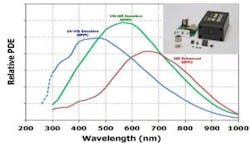Hamamatsu to showcase multi-pixel photon counters at SPIE Photonics West 2018
The company's multi-pixel photon counters (MPPCs; a type of silicon photomultiplier) have sensitivity in the UV, visible (VIS), and near-infrared (NIR) regions, and are designed for various low-light applications. The UV MPPCs have peak sensitivity at 128 nm for high-energy physics; the UV-visible MPPCs have peak sensitivity at 450 nm for scintillation-based applications such as medical imaging; the VIS-NIR MPPCs have peak sensitivity at 600 nm for medical or life science applications; and the NIR-enhanced MPPCs have peak sensitivity at 905 nm for light detection and ranging (lidar) systems.
SPIE Photonics West booth number: 521
To Learn More:
Contact: Hamamatsu
Headquarters: Bridgewater, NJ
Product: Multi-pixel photon counters (MPPCs)
Key Feature: Sensitivity in the UV, VIS, and NIR
What Hamamatsu says:
View more information on the multi-pixel photon counters (MPPCs).
Locate a vendor or system integrator in our Buyer's Guide.
Share new products that you think are particularly interesting or helpful by contacting Lee Dubay, Associate Editor, Laser Focus World.
